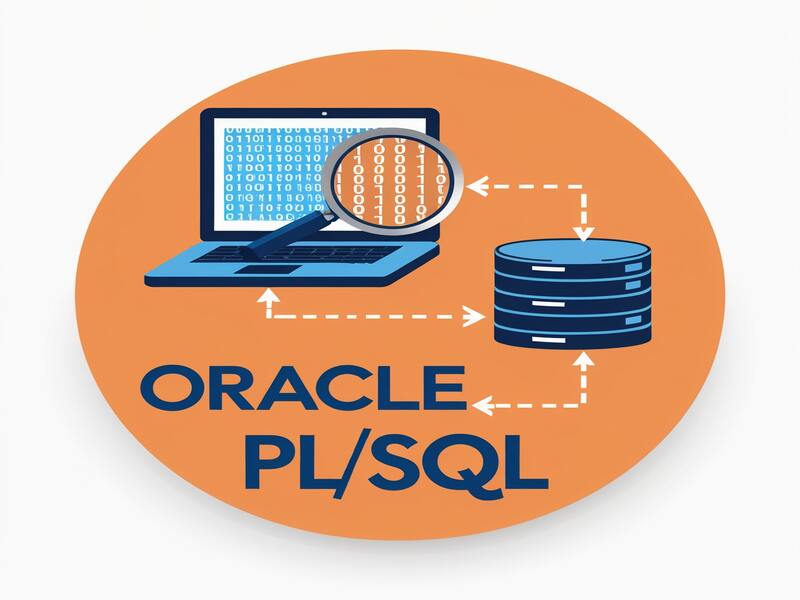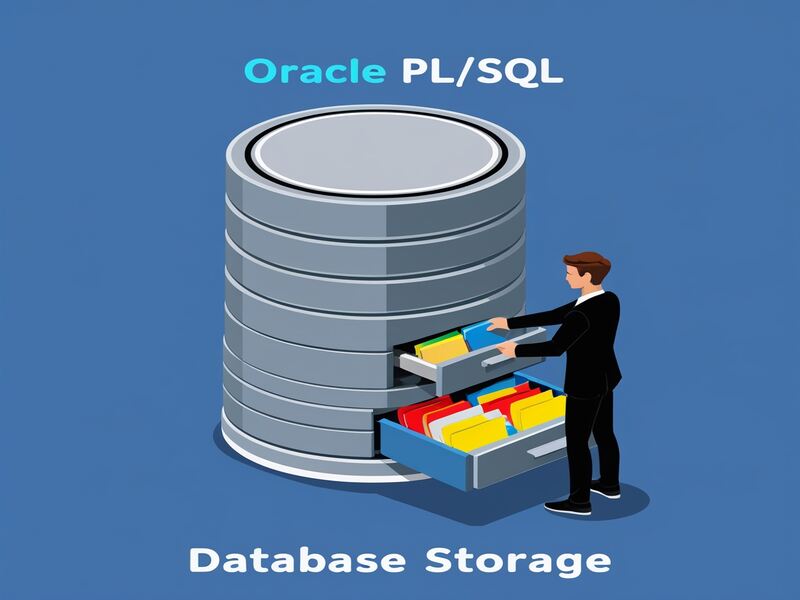Oracle PL-SQL Tutorial
What is Oracle PL/SQL?
Oracle PL/SQL is a procedural language and extension of SQL used to write procedures, functions, and triggers in the Oracle database management system.
It combines SQL’s data manipulation capabilities with procedural programming languages like loops, conditionals, and variables.
PL/SQL is crucial to Oracle’s database management system because it is used for tasks like data validation, transaction processing, and report generation.

Definition of Database Management Systems (DBMS)
DBMS system software allows users to define, create, maintain, and manipulate databases.
It serves as a memory for collecting interrelated data and is considered a valuable asset for managing information.
Types of Databases
There are two main types of databases: real-time Online transaction processing (OLTP) and real-time Online analytical processing (OLAP).
OLTP databases are used for daily transaction information management, while OLAP databases are used for analytical processing and decision-making.
Difference between Data and Database
Data is the raw information collected, while a database is the structured collection of interrelated data managed by a DBMS.
Data becomes a database when organised in a specific structure, allowing for efficient information management and retrieval.
Purpose of OLTP Databases
OLTP databases are used for real-time transaction processing, transaction management, and transaction information management.
They are designed to handle many short online transactions and provide fast response times.
OLTP Software
OLTP software includes popular DBMS such as Oracle SQL Server, MySQL, Db2, and Sybase.
These software programs are used for various purposes, including transaction management, transaction information management, and maintenance.
They provide a robust platform for managing and manipulating OLTP databases.

Advantages of Books and Files for Data Management
Books and files are both helpful inorganising and managing data. Books provide a tangible medium for storing information, while files offer a structured way to manage data digitally.
Both books and files can be easily searched, accessed, and shared, making them valuable tools for data management.
Role of Database Management Systems
Database Management Systems (DBMS) are software applications that manage and maintain databases.
DBMS provides a robust platform for defining, creating, modifying, and querying databases, making it easier for users to manage and analyse large amounts of data.
Differences between Books, Files, and Databases
Books, files, and databases all organise and manage data, but they serve different purposes.
Books provide a physical medium for storing information, while files offer a structured way to manage data digitally.
On the other hand, databases are designed to manage large, complex databases, providing a range of tools and features for data definition, manipulation, and querying.
While books and files can be used to manage small, simple datasets, databases are better suited for managing large, complex datasets that require advanced features and functionality.
How Data Used in Organizations
Data is a critical component of any organisation, as it can provide valuable insights and information that can be used to make informed decisions.
Data can also be a source of conflict, inconsistency, and security concerns, making proper data management essential.

Oracle PL-SQL Training

Advantages of Data Management Systems
Data management systems have been introduced to help organisations maintain and access business-related information.
These systems provide a range of benefits, including improved data consistency, enhanced security, and increased data accessibility.
What are the challenges of Data Management Systems?
Despite data management systems’ benefits, several challenges must be addressed to ensure their success.
These challenges include flag files, platform problems, and flat files, impacting data consistency, security, and accessibility.

Impact of Data Inconsistency
Data inconsistency can lead to various issues, including data re-entry, security concerns, and data integrity problems.
Proper data management practices, including data validation, normalisation, and backup, can help prevent data inconsistency and ensure data is accurate, secure, and accessible.
Importance of Data Security
Data security is critical to data management, as it helps protect sensitive information from unauthorised access, use, or disclosure.
Proper data security practices, including encryption, access controls, and regular backups, can help ensure that data is protected and secure.
Definition of Duplicate Data
Duplicate data refers to the same data or information stored in multiple files or locations.
This can occur when the same data is entered multiple times or when data is copied or duplicated from one file to another.
Advantages of Storing Data in Multiple Files
Storing the same data or information in multiple files can provide several advantages, including easy access to the same information from various sources, improved data redundancy, and increased data availability.
Preventing Duplicate Data
Preventing duplicate data is an essential aspect of data management and can be achieved through several methods, including data validation, normalisation, and file linking.
Organisations can improve data consistency, reduce data storage requirements, and increase data accuracy by preventing duplicate data.

Importance of Understanding Data Storage Mechanisms
Understanding the system’s data storage mechanisms is critical for effective data management. By understanding how data is stored and accessed, users can better manage their computer’s data storage and avoid potential issues, such as data inconsistency and redundancy.
Definition of Data Redundancy & Data Consistency
Data redundancy refers to the problem of storing the same information in multiple files or locations. This issue can occur for various reasons, including using flat files, which do not have a mechanism to prevent data redundancy.
Data consistency refers to the difference between the same information stored in multiple files and the same information stored in different files.
Various factors can cause data consistency inconsistencies, including the file type, the number of files being opened, and the size.

Oracle PL-SQL Online Training

Consequences of Data Redundancy
Data redundancy can have several negative consequences, including increased data storage requirements, inefficiencies, and errors. Organisations can improve data consistency, reduce data storage costs, and increase data accuracy by addressing redundancy.
Importance of Data Consistency
Data consistency is critical for effective data management, ensuring that data is accurate, reliable, and up-to-date.
Proper data management practices, including data validation, normalization, and backup, can help prevent data inconsistency and ensure data consistency and accuracy.

Solutions for Data Redundancy and Data Consistency
Solutions for data redundancy and data consistency include data validation, normalisation, file linking, and backup.
By implementing these solutions, organisations can ensure that data is accurate, consistent, and up-to-date and that data storage and management practices are efficient and effective.
Importance of Clarity and Accuracy in Submission Process
Clarity and accuracy in the submission process are critical for effective data presentations. Providing accurate information about the person’s name and specific identity details can help prevent misunderstandings and errors and ensure the information is presented consistently and accurately.
Consistent Data Presentation
Consistent data presentation is critical for effective data management, ensuring that data is accurate, reliable, and up-to-date. Proper data management practices, including data validation, normalisation, and backup, can help prevent inconsistent data presentation and ensure data is presented consistently and accurately.
Importance of Data Validation
Data validation is the process of checking data for accuracy and completeness. By implementing data validation, organisations can ensure that data is accurate, reliable, and up-to-date and that data management and storage practices are efficient and effective.
The Right and Recovery Triangle
The right and recovery triangle is a concept that highlights the importance of having the correct data available for data retrieval.
The data required is needed to retrieve the data from files, and having accurate and consistent data is critical for effective data retrieval.
Solutions for Efficient Data Retrieval
To address the issue of slowness in data retrieval, developing an application using procedural languages, such as C++, Java, and DotNet.
These languages can be used to represent the data and are more efficient than using flat files.
Using the visa procedure to develop one language for each application program, which involves writing code in one language for each application.
This approach can help improve data retrieval performance and reduce data retrieval time.

Importance of Data Validation and Normalization
Data validation and normalisation are critical for effective data management practices. Data validation ensures that data is accurate and complete, while normalisation helps reduce data redundancy and inconsistencies.
By implementing these data management practices, organisations can ensure that data is accurate, reliable, and up-to-date and that data management and storage practices are efficient and effective.
Differences between Data and Information
Data and information are two related but distinct concepts. Data refers to raw, unprocessed facts and figures, while information is the processed, meaningful data that provides insights and value to the user.
Data can be stored in multiple files, while information results from processing and analysing data to extract meaning and value.
Importance of Data Storage and Management Practices
Proper data storage and management practices are critical for effective data management.
By implementing best practices, including data validation, normalisation, backup, and recovery, organisations can ensure that data is accurate, reliable, and up-to-date and that data management and storage practices are efficient and effective.

Oracle PL-SQL Course Price


Saniya
Author